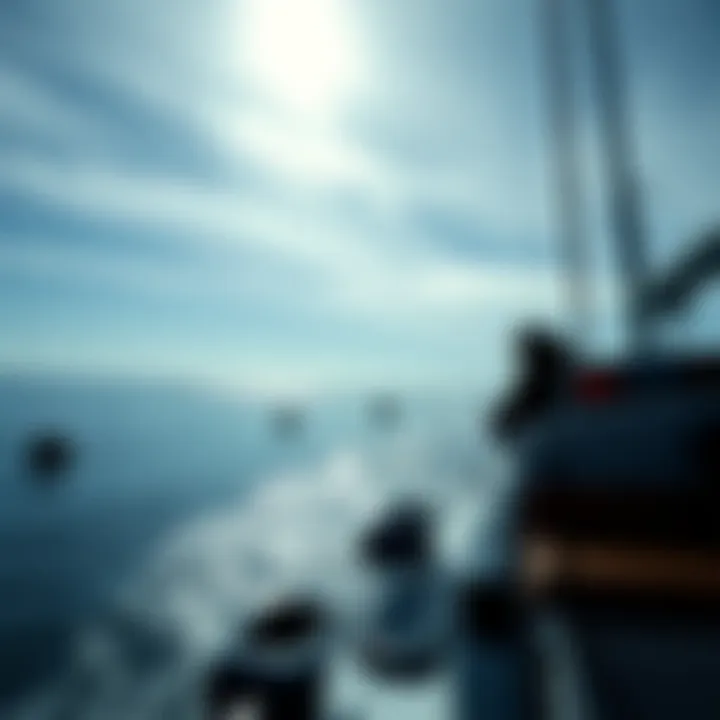Understanding High Tides in Boston: A Detailed Analysis


Intro
Navigating the intricate relationship between tides and watersports in Boston is not just for the marine biology nerds. It's vital for surfers, paddleboarders, kitesurfers, and instructors alike. Understanding high tides isn't merely about knowing when to hit the waves; it's about safety, gear choice, and embracing the unique, often complex rhythms of the water. With a city rich in maritime history and a diverse coastal landscape, Boston provides both challenges and rewards for enthusiastic water adventurers.
In the realm of watersports, high tides can make or break an outing. Tidal shifts affect currents, wave conditions, and even water temperatures, all of which are critical for anyone looking to enjoy the oceanic playground. As we move through this article, we’ll unravel the science behind these tidal forces, trace their historical significance, and dive into practical advice tailored for both beginners and seasoned veterans.
Gear Essentials
Choosing the right gear can feel like navigating a maze. For those keen on watersports, understanding the essentials is crucial to ensure safety and enhance your experience on the water.
Top Picks for Watersports Equipment
When it comes to equipment, not all gear is created equal. Whether you are paddling through the harbor or catching a swell, having the right tools can make a sizable difference in your performance. Here are a few top picks that can gear you up for success:
- Surfboards: Longboards are excellent for beginners, providing stability in various conditions, while shortboards cater to advanced riders who prefer agility and trick maneuverability.
- Paddleboards: For paddleboarding, the inflatable models are trending. They’re portable and easy to store – perfect for city dwellers.
- Kite Surfing Kits: Brands like Naish and Cabrinha offer reliable kites that can withstand the brisk winds of Boston’s coastline. Investing in a quality harness is equally crucial for durability.
- Wetsuits: The ocean can get quite brisk, especially in the early spring. A thick 4/3mm suit is ideal for most conditions, while a 3/2mm will suit the warmer days.
Maintenance and Care Tips for Gear
It's all well and good to have the best gear, but without proper care, you might as well be throwing money down the drain. A few simple maintenance tips can keep your gear in top shape:
- Rinse gear in freshwater after each use to remove salt and prevent corrosion.
- Check for any damage like dings in surfboards and seal them up with repair kits.
- Store your wetsuits and inflatable boards away from direct sunlight to prevent wear and tear.
Techniques and Tips
Familiarity with water conditions is important, but how you ride those waves matters just as much. Here’s how to elevate your experience on the water:
Beginner Tips for Each Watersport
If you're just starting out, knowledge is power. Here are simple but effective tips for new enthusiasts:
- Surfing: Start with smaller waves and practice your balance on the board while in shallow water before venturing out.
- Paddleboarding: Keep your knees bent and stand with your feet parallel to maintain balance. Don’t forget to use your core!
- Kite Surfing: Always check wind conditions before heading out. Practice with a trainer kite on land when you're new to it.
Advanced Techniques for Skill Enhancement
For seasoned participants, pushing boundaries can be thrilling:
- Advanced Surfing: Experiment with cutbacks and volume tenacity to improve your wave riding.
- Paddleboarding: Work on your stroke efficiency; switch between paddle strokes to maximize speed and minimize fatigue.
- Kite Surfing: Master transitions and jumps; understanding your kite control will greatly enhance performance.
Engaging with Boston’s waters during high tides can serve up a unique experience, shaped by both the thrilling elements of the ocean and the personal challenges you dare to take. This exploration of tidal forces not only enhances safety but crafts a deeper appreciation for the waters we cherish.
With knowledge about tides and effective gear in our belt, we can revel in the aquatic wonders while being fully prepared for whatever nature throws our way!
For further information, resources like Wikipedia, explore Britannica about the science behind tides, or join discussions on Reddit for a community perspective on gear advice and water sport experiences.
Prologue to Tides
When we think about water and recreation in Boston, the rhythm of the tides is a crucial element that shapes the experience. Understanding tides isn't just for scientists; it's vital for anyone who enjoys water sports. High tides, specifically, can play significant roles in the types of water activities available, the safety precautions to consider, and the timing of outings.
Tides are essentially the regular rise and fall of sea levels, influenced mainly by the gravitational pull between the Earth, the Moon, and the Sun. This gravitational interaction creates a fascinating dance that alters the very landscape of coastal areas. For watersport enthusiasts, knowing how high tides work can deepen your appreciation for the natural world while ensuring that you enjoy your activities to the fullest.
Definition of Tides
Tides are periodic changes in water levels of oceans and large water bodies, occurring approximately every six hours. This fluctuation is not random; rather, it follows a predictable cycle based on lunar phases and the Earth's rotation. In simple terms, when the Moon is directly above, it pulls the water towards it, resulting in a high tide. Conversely, when the Moon situated at a 90-degree angle to a certain point, the water level drops, marking a low tide.
This cyclical nature leads to two high tides and two low tides in most locations each day, but the timing and height of these tides can vary due to geographical and meteorological factors. Boston, with its unique coastal features, exhibits complex tidal behavior that is essential knowledge for surfers, paddleboarders, and kitesurfers alike.
Mechanics Behind Tidal Movements
To grasp how tides work, one must consider a few key concepts:


- Gravitational Forces: The Moon's gravitational pull is the primary driver of tidal changes. However, the Sun also contributes, albeit to a lesser extent. The combined gravitational influences create different tidal heights.
- Centrifugal Force: As the Earth rotates, it creates a centrifugal force that contributes to the formation of high tides on the side opposite to the Moon.
- Local Geography: Boston's unique coastline, with its harbors and bays, can amplify or reduce tidal effects. For instance, some areas may experience higher tides than others based purely on their location.
"Knowledge is power; understanding tides is essential for a safe and enjoyable experience on the water."
For further reading on tides and their effects, you may visit resources like Wikipedia or Britannica to delve deeper into the subject.
Tidal Patterns in Boston
The tidal patterns in Boston offer a fascinating glimpse into the rhythmic dance of water influenced by various forces. Understanding these patterns is essential for both water sports enthusiasts and those interested in the environmental aspects of the coastal ecosystem. The tides dictate when and how activities such as surfing, paddleboarding, and kitesurfing can be conducted safely, making it crucial for anyone engaging in water sports to stay informed.
Boston experiences semi-diurnal tides, which mean there are typically two high tides and two low tides each day. This pattern is influenced heavily by the gravitational pull of the moon and the sun, along with the local geography of the coastal area.
Knowing high tide timings not only enhances one's experience on the water but also influences safety measures and equipment needed for various water activities. For surfers, knowing when the tide is high can change the approach for the session, whereas for paddleboarders, it can determine suitable launch times and routes.
Historical Analysis of Tidal Changes
Historically, Boston's tidal patterns have been influenced by both natural phenomena and human activities. Over the years, alterations in the landscape due to construction, as well as climate change, have played significant roles in impacting tidal movements. For example, the construction of piers and waterways has altered water flow dynamics, leading to changes in tide heights and timings.
Additionally, the historical data show fluctuations in tidal ranges over decades. Understanding these changes sheds light on how water activities were once conducted and how they might evolve in the future. An analysis of sequences of past tidal patterns creates a solid foundation for predicting future tides, therefore providing a base for safe aquatic engagements.
Current Tidal Data
Having access to current tidal data is indispensable for all who venture into Boston's waters. Accurate, real-time data contributes to better planning for water sports and recreational activities.
Table of Today's High Tides
The Table of Today's High Tides serves as a critical tool for those looking to optimize their water endeavors. It provides specific timings and heights for high tides, allowing enthusiasts to plan their day carefully around optimal conditions.
One striking aspect of this table is the clarity with which it presents information. It typically features not only high tide heights but also low tide timings, which is beneficial as it allows users to see the complete tidal cycle at a glance. The predictability of these tides is a huge plus for surfers and kayakers who might want to wait for the right moment to execute their sports effectively.
However, while it serves as an excellent learning tool, it’s worth noting that reading tidal data can be tricky for a novice. Misinterpretation can lead to unforeseen conditions on the water, thus, continuous education on how to read these tables is advisable.
Comparison with Historical Tide Data
The Comparison with Historical Tide Data allows for a detailed analysis of how current tidal conditions stack up against past trends. This critical examination not only highlights changes in tidal heights but also shifts in timing that might affect aquatic activities.
Here, one of the unique features is the ability to observe anomalies or significant trends over time. For instance, are today's high tides more pronounced than those of 20 years ago? Such data can inform current practices in water sports, posing questions about equipment adjustments or the need for alternative locations due to shifting tides.
By comparing historical data with the current tidal information, users can draw insights that influence their decision-making process while navigating local waters. Filtering out this comprehensive data can also better prepare seasonal participants in the water sports community, making it easier to adjust to changing conditions without compromising safety.
As a whole, understanding tidal patterns, and analyzing historical and current data is paramount in fostering a community that not only thrives on recreational water sports but also respects the environmental dynamics that shape the waters of Boston.
Environmental Factors Influencing Tides
The environmental factors affecting tidal movements are as varied as they are significant. Understanding these influences is crucial, especially for enthusiasts of water sports in Boston. The interplay between gravitational forces and meteorological phenomena can shape tidal experiences, impacting everything from water conditions to safety measures.
Gravitational Forces' Role
The gravitational pull of the moon and sun is perhaps the most recognizable force influencing tides. It's like a cosmic dance where the moon is the leading partner, exerting its gravitational force on Earth’s waters. This pull causes water to bulge, resulting in high tides, while areas perpendicular to this bulge experience low tides.
One of the key characteristics of this phenomenon is its predictability; tidal cycles are regular and can be forecasted days or even months in advance. For water sport enthusiasts, knowing these patterns can ensure that they are on the water during optimal conditions. However, a notable feature of gravitational influence is how it varies with the moon's phases. For instance, higher than average high tides occur during full and new moons, a time when the sun, moon, and Earth align. This property can occasionally lead to flooding events, especially in coastal areas where the elevation is low.
Meteorological Influences
Tidal patterns are not solely dictated by gravitational forces; meteorological influences also play a significant role in shaping water levels and currents.
Wind Patterns
Wind patterns are critical because they can drive water from one place to another, affecting the local tidal height. When strong winds blow in a particular direction, they can push water toward shore, creating higher tides, known as ‘storm surges’. This is especially noteworthy during storm events, where the added pressure from wind can raise water levels even more dramatically than expected.


A key characteristic of wind patterns is their variability; factors such as speed, direction, and duration can uniquely alter local tidal conditions. This makes understanding local winds beneficial for water sports like surfing and kitesurfing. Surfers, for instance, can take advantage of winds that align with incoming waves to achieve a more exhilarating ride. However, adverse wind conditions can equally lead to dangerous situations, underscoring the need for caution and preparedness.
Atmospheric Pressure Changes
Atmospheric pressure changes are another crucial aspect that can influence tidal movements. When high pressure dominates, sea level can drop slightly, while low atmospheric pressure can result in an increase in sea level. This phenomenon is often overlooked but can have significant effects, particularly during weather events like hurricanes or heavy storms.
A defining characteristic of atmospheric pressure is its capacity to fluctuate often and rapidly, leading to unpredictable tidal responses. For example, shifts in pressure systems can coincide with other tidal influences, amplifying the tides and causing unusual surges. For water sports practitioners, awareness of these changes is vital. Riding waves during low-pressure systems can be thrilling but risky if one is not adequately prepared for the resulting conditions.
Understanding the full scope of environmental factors influencing tides can significantly enhance your aquatic experience.
In summary, while gravitational forces govern the foundational designs of tides, meteorological influences like wind patterns and atmospheric pressure changes play equally vital roles. Enthusiasts should incorporate these factors into their planning, ensuring safer and more rewarding experiences on the water.
Impact of Tides on Water Sports
Understanding the rhythm and flow of tides is pivotal for any water sports enthusiast, especially in a dynamic port city like Boston. The way that high tides shift the water conditions drastically affects not just the experience but also the safety and effectiveness of various activities such as paddleboarding, surfing, and kitesurfing. This section delves into these influences and outlines the significance of being aware of tidal patterns while engaging in water sports.
Understanding Water Conditions
Tides create varying water conditions that can make or break a water sports outing. During high tide, the water level rises, leading to different wave patterns, currents, and obstacles. For instance, high tides might wash away sandy bottoms, unveiling rocky shores or other hazards that are not visible during a low tide. It's essential for water sports enthusiasts to familiarize themselves with these conditions to avoid accidents and genuinely enjoy their time on the water.
Observing tidal charts and knowing the timing of high tides can assist paddleboarders, surfers, and kitesurfers not only in safety but also in maximizing fun. A high tide can excite the waves, generating more swell for surfers or providing better conditions for kitesurfing. But it can also mean stronger currents, which can be a problem for less experienced athletes.
Best Practices for Water Sports during High Tide
Paddleboarding Considerations
When it comes to paddleboarding, timing is everything. Launching at high tide can be a splendid choice because the water tends to be deeper and more open, away from rocky hazards. However, one must be cautious as the water is often murkier, making visibility poor. Anchor your paddleboard securely if you’re taking a break, lest you find yourself drifting away with the tide.
Instructors often recommend checking the weather before heading out. Wind conditions shift during high tide, potentially creating rougher waters. Overall, paddleboarding is a fantastic way to enjoy the ocean’s bounty, provided one assesses the water’s temperament first.
Surfing at High Tide
Surfing at high tide can be a double-edged sword. On one hand, it opens up the beach to potential setups with fun waves rolling in, especially along certain reefs and sandbars. On the other hand, these conditions can lead to formidable swells and quick currents that test the skill of even seasoned surfers.
The unique feature of surfing during high tide is the ability to catch waves that may not break or form properly at low tide. That said, understanding the coastline is crucial. A lack of knowledge could lead to nasty wipeouts or, worse, dangerous situations. Surfboards should be equipped with leashes to prevent losing gear in unpredictable tides.
Kitesurfing Safety Tips
Kitesurfing demands a keen understanding of tidal dynamics, especially during high tides. The main characteristic here is the wind. It can be more unpredictable near shorelines where tidal shifts occur. Enthusiasts should always check wind reports and assess whether the conditions are safe for flying kites.
Kitesurfers find themselves riding waves and performing tricks that are thrilling but can also be risky. An optimal safety tip is to ensure that your kite has a quick-release system. This allows for easy detachment during emergencies. Learning to gauge tide changes is paramount, as shifting tides can expose a kitesurfing novice to serious hazards, such as running aground.
"Understanding the interplay between tides and water sports can significantly enhance your overall experience and safety on the water. Staying informed allows for a more enjoyable and secure time during your aquatic adventures."
For more detailed information on tidal patterns and their impact on water sports, consider visiting resources like NWS Tides and Currents or exploring community forums on Reddit.
Safety Precautions
Understanding safety precautions is essential for anyone partaking in water sports during high tide events. High tides, though fascinating, come with their own set of challenges and risks. When the sea swells, it alters the landscape of our shoreline, making areas that seem safe at low tide suddenly perilous. Therefore, knowledge of the risks involved and the necessary safety measures not only enhances enjoyment but can be the fine line between a thrilling experience and a dangerous situation.
Understanding Risks
Every outdoor adventure holds inherent risks, and water sports are no exception. High tides can lead to swift currents, sudden wave actions, and unpredictable conditions that may overwhelm even seasoned water enthusiasts. For surfers, paddleboarders, and kitesurfers, it’s crucial to recognize how these factors play into their activities.
- Strong Currents: With tides rising, water movement may accelerate, creating unpredictable conditions. Getting swept away or pulled under is a very real concern. This is where skills in assessing current strengths become paramount.
- Exposed Hazards: Shallow areas that were previously accessible can transform rapidly in high tide, hiding rocks or debris that could cause injury. Knowledge of the area is vital.
- Limited Exit Points: During high tides, it’s crucial to know safe routes back to shore. An emergency might mean needing to swim against challenging waves that weren’t there moments before. Practicing awareness and planning exit strategies keeps safety in focus.
In summary, becoming informed about these risks empowers water sports enthusiasts to navigate the tides confidently and enjoy their aquatic activities without unnecessary hazards.
Essential Safety Gear


Equipping oneself with the right safety gear is as important as understanding the risks. Personal flotation devices and communication equipment are fundamental components that can make a world of difference when challenges arise at sea.
Personal Floatation Devices
Personal flotation devices, often referred to as life jackets, are indispensable for anyone venturing out on the water. Their primary role is to keep individuals buoyant and secure in case of unexpected dips into the water.
A key characteristic of these devices is their design that allows for freedom of movement while ensuring safety. For many, investing in a high-quality personal flotation device can represent a wise choice when participating in water sports. These devices usually include features like adjustable straps and removable cushioning, which enhance comfort. They come in various types, such as Type III vests designed for high-activity sports like kitesurfing.
However, not all PFDs are created equal. It’s essential to choose one that meets the specific requirements of your activity. If the PFD does not fit well, it may not function optimally when it needs to—an uncomfortable fit can lead to neglecting to wear it at all, which could be catastrophic. Moreover, familiarity with how your device operates before hitting the high tides can be life-saving.
Communication Equipment
In the digital age, communication equipment such as VHF radios or waterproof mobile phones hold immense value for water sports participants. They serve as critical tools for maintaining contact with fellow enthusiasts or alerting emergency services if needed.
A primary advantage of using communication equipment is portability. Many devices today are compact and can easily fit into a pocket. This ease of access can make them a popular choice among surfers and paddleboarders.
However, they do come with their challenges. Battery life is crucial—during extended ventures on the water, it’s important to have a means of keeping the device charged. Additionally, potential breakdowns are a reality that can leave one feeling isolated and unprotected. To mitigate this risk, familiarizing oneself with the operation and features of your communication device before hitting the waves is critical.
"The sea is a master of disguise, and anyone who underestimates its power could find themselves in over their head."
Community and Resources
The examination of tides in Boston extends beyond just facts and figures; it deeply involves the community engaged in water sports and the resources available to them. Understanding this aspect is crucial for both novices and veterans aiming to capitalize on high tides while ensuring their safety and enjoyment in the water. Resources and community engagement pave the way for better knowledge, skill development, and collaboration among water enthusiasts. They serve as a support system, fostering a culture of learning and safety as tides ebb and flow.
Local Water Sports Groups
Local water sports groups in Boston provide a vital sanctuary for enthusiasts. These organizations unite paddleboarders, surfers, and kitesurfers who share a common passion. They often offer structured events, meet-ups, and social gatherings which help foster camaraderie among participants. Joining such groups can expose members to:
- Skill Development: Classes and workshops led by experienced instructors help improve techniques and build confidence.
- Networking Opportunities: Connecting with others can lead to new friendships and partnerships in water sports.
- Access to Resources: Groups usually have valuable information about tide schedules, safety practices, and the best spots.
Inevitably, participation in these groups can cultivate a strong sense of community, making the experience more enjoyable and enriching.
Educational Workshops and Events
Educational workshops and events stand as another pillar of resource support for water sports enthusiasts in Boston. These initiatives are essential for raising awareness of tidal dynamics and enhancing safety practices. Workshops often cover a range of topics from tidal science to practical skills and safety gear usage. Here’s what you might find:
- Safety Workshops: Programs designed to educate participants about potential hazards associated with tides and water sports activities. Topics include first aid in aquatic settings and how to use safety equipment effectively.
- Tidal Studies: Events focusing on understanding tidal phenomena in Boston. Knowledge gained can aid participants in planning their activities in tune with tidal movements.
- Community Days: Both fun and educational, these gatherings connect athletes and families through games, demonstrations, and expert talks.
Experience is the best teacher, but with the right resources and workshops, Boston's water sports community can turn the tides in favor of safety and enjoyment.
Investing time in community engagement and attending workshops can significantly enhance one’s experience, making time on the water safer and more fulfilling. Ultimately, the intersection of community spirit and educational resources forms a robust foundation for all who seek to ride the waves in Boston.
Culmination
Understanding high tides in Boston serves as a crucial element in many facets of maritime life, especially for those engaged in water sports. The intricate dance of the moon and sun's gravitational pull, coupled with local geographical features, creates a unique tidal system that demands respect and understanding. By navigating these waters mindfully, enthusiasts can optimize their experience, ensuring safety and enjoyment.
Recap of Key Insights
High tides in Boston play a pivotal role in shaping aquatic activities and communities. Here are the primary takeaways from this exploration:
- The Science of Tides: Tides arise from the gravitational attraction exerted by the moon and sun and the Earth's rotation. High tides occur approximately every 12 hours and 25 minutes, resulting in a predictable rhythm that can be charted.
- Historical Context: Over the years, tidal patterns have changed due to environmental factors like land reclamation and climate change. Understanding these shifts aids in anticipating localized tidal events.
- Impact on Water Sports: High tides can significantly influence water conditions, affecting the safety and experience of paddleboarders, surfers, kitesurfers, and other enthusiasts. Being aware of the tide schedule translates to better preparation and risk management.
- Safety Precautions: Emphasizing the importance of Personal Floating Devices (PFDs), effective communication tools, and understanding the risks inherent during high tide periods ensures that participants can enjoy the water responsibly.
Looking Ahead: The Future of Tides in Boston
As climate change progresses, we may witness changes in tidal patterns, potentially increasing their intensity and frequency. Knowledge of these shifts will be essential for community adaptation.
- Monitoring Tidal Changes:
- Community Engagement:
- Educational Initiatives:
- Continuous monitoring through local authorities and research institutions will help stakeholders understand emerging patterns. Websites like NOAA and USGS can provide critical tidal forecasts as well as historical data.
- Building a collaborative platform for local water sports groups to share experiences and insights can lead to greater collective knowledge. Social media channels, such as relevant Facebook groups, offer spaces for discussions on safety and best practices during high tide.
- Workshops and seminars can be beneficial for all, drilling down into tidal science while also stressing safety precautions and environmental awareness. Keep an eye on local events through platforms like community boards and local event pages.
In summary, the tides of Boston are not just a natural phenomenon; they are part of a larger narrative that brings together enthusiasts, nature, and science. Whether one is a seasoned surfer or a novice kayaker, understanding these tides will remain fundamental for safe and fulfilling water adventures.



